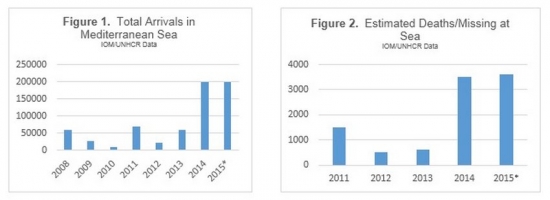
Current Flows across the Mediterranean
There is almost universal agreement that Europe’s current migration policy is both a practical and a ethical failure. There have been periodic low-level rumblings decrying current policy and demanding reform over the last decade, but these voices have become considerably stronger in 2015. A major reason for this, of course, is the increase in deaths in the Mediterranean; an estimated 1,700 migrants died in the first four months of 2015, compared to around 96 over the same period in 2014.
Figures 1 and 2 illustrate estimates of both the recent flow of refugees over the Mediterranean, and the number of likely deaths.

*Figures for 2015 are extrapolations for the full year based upon arrivals and deaths in the first 6 months of 2015. The 2015 data used includes both the first 4 months of the year – when deaths were very high – and following 2 months, when increased naval rescue operations took total fatalities down to comparatively low levels, which explains why the 2015 figure averages out to approximately the same as that of 2014. (* Pritchett, Lant. Let their people come: Breaking the gridlock on global labor mobility. Washington, DC: Center for Global Development, 2006.)
There are several points worth elucidating from these graphs. First, considerable numbers of migrants have been trying to cross the Mediterranean for almost the last decade, and entirely unacceptable numbers have been dying in the attempt. Second, both the number of migrants and the number of deaths have increased significantly over the last two years.
What explains the explosion in the number of people who are willing to make the difficult and dangerous journey across the Mediterranean? Academics typically analyze migration flows using a push/pull framework. Factors affecting the migration decision are categorized into ‘pull factors’, which make the destination country more attractive, and ‘push factors’, which make the origin country less attractive. The idea is that an individual will migrate if they judge that their expected utility in the destination country will be higher than their expected utility in the origin country. There are several problems with this framework, which fails to take into account the impact of existing social and economic structures, and which cannot take into account motives of, for example, risk diversification, but it is useful in providing insights into current migration across the Mediterranean.
Viewed through this lens we can explain the spike in crossings as a result of an increase in ‘push factors’, with the ongoing Syrian civil war and the continued existence of a deeply repressive regime in Eritrea typically seen as the two most important. In fact, the International Organisation for Migration (IOM) has hailed the Syrian civil war as “the biggest movement of people since world war two”, with as estimated 8m people (from an estimated total population of 22m in 2010) being displaced inside the country and 4m having left the country entirely. An important contributory factor has been the destabilization of Libya; the effective total collapse of state capability since 2011 has both provided would-be migrants with a relatively straightforward route to the southern shores of the Mediterranean, and given human smugglers a comparatively hassle-free base from which to operate.
This is not a problem that is simply going to go away. Boats full of migrants arrive every day, and there have been reports of up to 600,000 people waiting in Libya for the opportunity to cross. In addition, the continued ‘arc of instability’ around the eastern and southern borders of Europe shows no signs of stabilizing, and is likely to continue to provide a steady stream of would-be migrants. Europe therefore cannot afford to simply continue to do nothing—far-reaching reforms to the current policy on immigration, asylum and labor mobility are required.
What can be done?
After the spate of drownings in April EU states announced—understandably—that the first priority must be to halt the spiraling death toll. There was, however, some disagreement about the best way to achieve this. There were, and are, broadly two schools of thought: some argue that the best way to prevent deaths is to deter migrants from attempting the crossing, while others support search and rescue operations to make the crossing safer.
The response of the EU, to its credit, was the latter. At a crisis meeting EU heads of state agreed to allocate considerably more resources to Operation Triton, the EU’s ‘border security’ operation. This appears to have been successful, as there has been a drastic reduction in deaths over the last few months. Self-congratulation would, however, be inappropriate; Triton still has fewer resources—and a smaller operational area—than its predecessor Mare Nostrum, which was discontinued by the Italian Government in 2014. They cited excessive costs and the refusal of other EU members states to offer financial assistance as the reasons for their inability to continue the operation. Amnesty International has gone so far as to call the additional support for Triton “a face-saving not a life-saving operation”.
There are still voices, however, that call for a switch to a tactics of deterrence, arguing not only that this would be a more effective solution, but that it also helps to solve the long term problem of the ‘excessive number’ of migrants arriving on European shores. In terms of our push/pull framework this amounts to targeting ‘pull factors’ by significantly decreasing the benefits that migrants might expect from attempting to cross. There is precedence here. Tony Abbott, the current Australian Prime Minister, made the slogan “stop the boats” central to his 2013 campaign, and have vowed to return all migrants attempting to access Australian shores. The result, apparently, has been that only one vessel has been intercepted in Australian waters since 2013 and deaths have reportedly plummeted. Mr Abbott has publically advised Europe that “the only way you can stop the deaths is in fact to stop the boats”.
Should we “stop the boats”?
Is he right? Should a policy be adopted of refusing entry to any migrant attempting an illegal maritime entry into Europe? Absolutely not, for a number of reasons. Firstly, and most importantly, this would be ethically outrageous. Some of those trying to cross are doubtless economic migrants, but a significant proportion are genuine asylum seekers, who are fleeing from countries in which their lives are in danger either through persecution or through conflict. And some of these conflicts, of course, have been exacerbated and extended by European involvement. Over half of migrants arriving in Italy last year were from Syria or Eritrea, and in the last quarter of 2014 two thirds of these migrants were granted refugee status. To argue that the ‘boat people; are almost entirely illegal economic migrants—as large proportions of the currently ascendant anti-immigrant right do across Europe—is to fly in the face of hard facts. We are surely morally obliged to provide what assistance we can. Even for purely economic migrants, however, the case is not clear cut, even if we leave to one side the set of arguments around the arbitrariness of international borders. To send migrants back to Libya is to leave them incredibly vulnerable to exploitation; many have exhausted their life savings in an attempt to get to Europe, and lack even a fraction of the resources required to make the journeys back to their home countries, even if they wanted to do so.
Secondly, we have clear-cut legal obligations to hear the claims of asylum seekers. Our laws contain considerable protections for refugees as a result of the 1951 UN convention. Our inability to take advantage of Mr Abbott’s advice is not just a matter of differences of interpretation of these laws between European and Australian lawyers; in 2012 the European Court of Human Rights ruled that boat people may not automatically be returned to their port of embarkation if rescued in international waters, and must be given a fair chance to apply for asylum. After the crimes of the World War II, countries made solemn vows never again to abandon the innocent to conflict and persecution. These were worthy and important promises that should not, under any circumstances, be abandoned.
Finally—and non-trivially—it is not even clear that refusing to allow migrants into Europe would be successful in stemming the flow of deaths in the Mediterranean. The best available data suggests that the same number of migrants attempted to cross in the first half of this year as last year, despite the enormous increase in risk as a result of the cancellation of Mare Nostrum. This is, of course, not by itself a watertight argument as we do not have a counterfactual for how many people might have attempted to cross in the absence of the cancellation—it may simply be that the number of potential migrants is higher, cancelling out the disincentive affects from the higher risk—but this statistic does at least demonstrate that the number of attempted crossings is fairly inelastic in terms of the risk of death. In addition, the length of the Mediterranean seaboard is such that it would be very difficult to successfully prevent all crossings, and for migrants with overwhelming ‘push factors’, such as those from Syria, even a slim chance of a successful crossing might well be enough to encourage the attempt. Finally, smuggling networks are highly lucrative; the UN says shipping migrants towards Europe from Libya is a $170m industry, and there will therefore still be huge economic incentives to continue covert smuggling operations.
If not deterrence, then what?
This essay has argued that the enormous number of dispossessed would-be migrants on both sides of the Mediterranean is not a problem that will go away by itself, and that trying to deter these individuals from coming is not the solution. I do not claim to have a simple solution—it seems obvious, in fact, that for a problem as complex as this simple solutions cannot exist. We can, however, perhaps try and isolate the current major stumbling blocks, and therefore zoom in on areas that must be addressed before we can begin a serious search of a better system.
The last few months have been the beginnings of a debate about the relative merits of paying North African countries to process visas for Europe, and using a convenient island nation as a provisional holding point. Discussing these proposals is beyond the scope of this paper, but it is important to note one general point about this debate: it has not been anything like as frequent or as loud as one might expect given the nature and severity of the issue. Nor has it been taking place at the levels necessary for there to be the prospect of discussions leading to any sort of policy action.
I would argue that this remarkable absence of political debate around long term policy solutions is partly denial. The EU asylum systems and arrangements for dealing with migrants are fragmented and, individually and collectively, wholly inadequate. There is no centralized mechanism for sharing refugees across the union, and the European Commission’s idea for compulsory migration quotas, which was floated earlier this year, died even before it had lived. I would argue that it is, in fact, an attempt to distract from the patent inadequacy of the current policy regime that is responsible, in large part, for the EU’s focus on the channels by which people originally arrive at its shores.
Migration on the Political Agenda
But I think we can go one problem deeper. Why are the EU systems for dealing with migrants and asylum seekers so inadequate, and why have we not seen more serious debate on these issues? I would argue that it is because of one of the natural conclusions of even the most cursory debate. If we agree that something must be done, and that deterrence is not morally or legally feasible, then it is almost impossible to escape the conclusion that EU states must, as part of the solution, take more asylum seekers and immigrants.
It is important here to briefly address one common major objection to the idea that taking more migrants is inevitable. Voices from across the political spectrum, insofar as they ever explicitly talk about immigration, can often be heard arguing that instead of assisting migrants once they get to our shores we should focus on supporting and developing the countries from which they originate. This opinion is generally formulated in one of two ways; some argue that increasing immigration is not possible, and that ‘development at home’ can be a substitute. The argument here is that development will decrease push factors, so that migrants will decide to stay at home. Other espouse the more altruistic, but related, notion that national development is a first best solution, and holds much more potential to decrease poverty than allowing increased access to European labor markets. Neither of these arguments hold water. In relation to the first, it is simply not tenable to maintain that ‘development at home’ is a substitution for migration. The international community has been pouring billions of dollars into the world’s poorest countries for over 50 years, and progress has—in most areas—been frustratingly slow. Government-sponsored external development assistance will not provide people with the wherewithal to significantly improve their lives over any sensible time horizon. More than that, and here we have also the response to those who argue that development is the first best solution, a growing body of literature (with the work of Michael Clemens of the Center for Global Development at the forefront) uses rigorous quantitative analysis to argue that increasing access to developed world labor markets offers economic gains that are “orders of magnitudes” greater than anything else on the development agenda—micro or macro.
There is a pretty convincing case that for Europe to take (in one way or another) more migrants is, for the foreseeable future, the only way out of the current situation in the Mediterranean. And yet we rarely, if ever, hear this explicitly in the national or international discourse. If fact, for a politician to propose this in the current environment is seen as certain political death.
Are politicians justified in their silence? It is certainly true that public opinion is increasingly anti-immigration in almost all EU Member States, and there are very few voices advocating for more immigrants or greater labor mobility for workers outside of Europe. In a hugely useful book on the subject, which I recommend wholeheartedly to anyone interested in this topic, Lant Pritchett isolates “eight immovable ideas” that are used to rationalize an anti-immigration stance.* In brief, these are that: 1. Nationality is a morally legitimate basis for discrimination;
2. There is a prevailing idea that the only two options are to keep people out or to admit them on the same terms as nationals;
3. We should think about ‘development’ as being about nations, rather than about individuals;
4. Labor movement is not ‘necessary’ to for development;
5. Increased migration of unskilled labor will depress wages or take jobs from nationals;
6. Migrants are a fiscal burden for receiving countries;
7. Allowing migrants brings a concomitant rising risk of terrorism and insecurity;
8. Culture clash is inevitable in high-immigration societies.
The point of this essay is not to discuss which of these have merit, which do not, or which might be malleable. It is instead to make the argument that concerted action on migration will not come until we can have an open, informed discussion about these objections. Only by sorting out the legitimate objections from the misinformation and the scare-mongering can we empower politicians to formulate politically feasible policies that can both end the gridlock in the Mediterranean and mitigate the possible negative effects of immigration at home.
Starting this process is harder than one might think, both because of the comparatively embryonic state of the academic literature on many of the above issues and because those who attempt to broach these conversations, or who disagree with accepted wisdom, are shouted down. We need journalists, politicians, academics, NGOs, and ordinary individuals who are brave enough to start a dialogue. Until we can achieve this there can be no serious attempt at policy reform at the national or the supranational level, and therefore no solution to the ongoing humanitarian crisis on the northern and southern shores of the Mediterranean. If we fail to act then history may look back on this as one of Europe’s greatest moral and political failings. Let us stop hiding our heads in the sand; this is a conversation whose time came long ago.
* The views and opinions expressed in the articles posted on this page do not necessarily represent the views and opinions of CIRSD

 Author:
Author:





